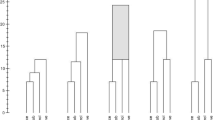Abstract
Lance and Williams (1966) introduced a generalized recurrence formula which can be used to compute the updated inter-cluster distance values resulting from the cluster fusion which occur at each level of a hierarchical clustering procedure. This paper develops an useful extension of this formula to pyramidal classification if the single, complete or average linkage technique is used. Furthermore it can be shown that in opposition to hierarchical classification only the complete linkage technique generates in the pyramidal classification structures with monotonically increasing distance values. Using the single or average linkage technique inversions are possible in the graphical representation of an indexed pyramid.
Similar content being viewed by others
References
Diday, E. (1987) Orders and overlapping clusters by pyramids, Rapports de Recherche, I.N.R.I.A. no 730.
Lance, G.N., Williams, W.T. (1966)A general theory of classificatory sorting strategies 1. Hierarchical systems, Computer Journal, vol. 9, p. 373–380.
Lasch, R. (1993)Pyramidale Darstellung multivariater Daten, Josef Eul, Bergisch Gladbach, Köln.
Milligan, G. W. (1979)Ultrametric hierarchical clustering algorithms, Psychometrika, vol. 44, no. 3, p. 343–346.
Opitz, O. (1980)Numerische Taxonomie, Fischer, Stuttgart, New York.
Author information
Authors and Affiliations
Rights and permissions
About this article
Cite this article
Lasch, R. Pyramidal clustering schemes. Statistical Papers 37, 235–251 (1996). https://doi.org/10.1007/BF02926586
Received:
Issue Date:
DOI: https://doi.org/10.1007/BF02926586




